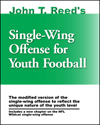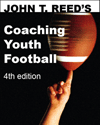John T. Reed's comments on
various youth football offenses


Here is a list of offenses and my comments on them. The only offense I have written a book specifically on is the Single-Wing Offense for Youth Football. I also cover offense in Coaching Youth Football and The Contrarian Edge for Football Offense.
Wing-T
Good for counters and waggle pass, good for spreading the ball around to three different running backs, otherwise no advantage to offense. This is one only three offenses that are adequately documented in books (the others are Hugh Wyatt’s double wing and my single-wing book), but I think it is not as successful as you would expect because it requires linemen to pull and/or block linebackers and corners often. In youth football, the linemen are often non-athletes who will drop out of sports by the time they are teenagers. The linebackers and corners, on the other hand, are future high-school stars. The typical youth lineman cannot block a youth linebacker or corner one-on-one and often is afraid to try.
The "I"
Ho hum. This is the favorite offense of your opposing defenses because it is the one they are most used to and comfortable with. Only useful for the blast play. This youth offense gives the most help to your opponent’s defense because they are so familiar with it.
Double wing (quarterback under center)
Killer all the way up through high school level. Emphasizes what young players do best: power running. Defenses are not set up for or used to dealing with so many blockers at the point of attack. Great wedge, off-tackle, and counters.
Single wing
Similar to double wing in its success and best plays. Better for passing than the double wing with the quarterback under center.
Short punt
Similar to double wing in its success and best plays. Better for passing than the double wing with the quarterback under center.
Option
I have never tried this or seen it tried by anyone who appeared to have given the quarterback enough practice making the read and pitch. Even so, it causes problems. The option was the dominant college attack in the ’70s and Oklahoma still holds rushing records from that era. Then it went away almost completely. Now it’s back as a sort of must-have component of a college offense. It screws up the defense something fierce. I suspect it would be the best youth offense, but you would have to get some good instruction on how to run it and you would have to give your quarterbacks enough reps to master it. For example, I suspect they might be able to play defense in games, but they would not have time to practice with the defense because they would need extra option practice time. DeLa Salle High School in Concord, CA runs the veer. They have now won 113 straight, the all-time high school record.
I bought former Houston coach Bill Yeoman's Veer playbook from him for $25. (3030 Country Club Boulevard, Sugar Land, TX 77478)
I highly recommed it. Looks like a great youth football offense and this college play book is both simple enough for youth football and very detailed.
Multiple
This is the most common high-school, college and pro offense. At the youth level, it’s more offense than you have time to put in. A youth coach who runs the multiple offense is showing his ignorance of how long it takes to put in a play and master it. The whole purpose of a multiple is to give you many tools to attack small weaknesses of each of the many defenses opponents use. In fact, most youth defenses use just a 5-3-3 or a 6-2-3. Why be multiple on offense when the defense is not multiple? Just run an offense that is strong where the 5-3-3 and 6-2-3 are weak.


Slot
Usually used by youth coaches who want to run the sweep or reverse, although it’s not strong at either unless the defenders at the point of attack are poorly trained.
Power I
Used by youth coaches who want to run the blast play. That will work against the usual youth defenses, but it's worthless against my gap-air-mirror defense.
Spread
Since youth teams generally cannot pass, this is usually a ploy to get the defense to hollow out it’s linebacking corps so the offense can run a dive or quarterback sneak. It almost never works. Might be better for the slant pass or Q-out route.
Shotgun
Tough to get pressure on the quarterback. That’s the bad news. The good news is youth teams generally cannot pass. Often used as a sort of sloppy single wing with the quarterback handing the ball to the guy next to him or the ball being snapped to someone other than the quarterback. If you want to run the single wing, do it right.
Lonesome polecat
Requires good passers, receivers and about four blockers. Will either be a disaster or a great success. I tried for two games once when I had an extremely weak junior-high age team in a league with many freshman high school opponents. It was a disaster because I only had about five good players.
Run and shoot
Ditto. The lonesome polecat is the father of the run and shoot.
Good luck,
John T. Reed